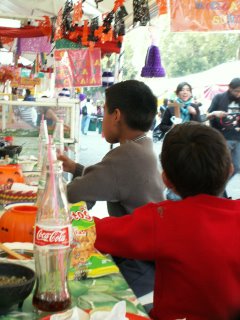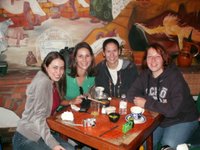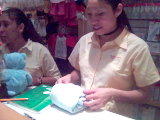My parents arrive in Mexico City tomorrow evening, so the following is a last minute advisory for them. This will also serve my future guests and anyone who ever plans to visit Mexico City or just wants a little bit of insider info.
THE AIRPORT
As you prepare to land at Mexico City International Benito Juárez Airport expect to receive a form to complete. The flight attendants should have these available in English; if they do not, you can wait until you are in the airport to complete the forms in English.
After disembarking, you will wait in a long line (it often takes up to an hour) and approach an immigration official who will review your passport and form and then give you a slip of paper. It is very important to keep this until you leave the country, otherwise you will have to pay a fee; I always keep it in my passport. As a side note, while in Mexico City you should not carry your passport with you; rather, keep it in a safe place. I do however carry a photocopy of it in my wallet -I assume (I hope correctly) this would help in case I lose the original.
Next, you will gather your luggage. As in most international terminals, carts are available free of charge. As you pass through sliding doors you will be met by another customs agent and a makeshift stoplight. You have to push a button on the light and wait to see if it turns green or red. If it is green, you are free to leave. If it is red your suitcases will be opened and the contents reviewed.
Finally, you will exit through sliding doors and beyond the barriers and rope there will be a mob of Mexicans waiting, waving hands and signs and yelling. At this point you will have to ditch your cart and lug your suitcases through the barriers.
Before leaving the airport, you should either exchange your dollars to pesos or if you didn’t bring much cash, use an ATM. The best exchange rates in the city are usually found in the airport - averaging just over 10.5 pesos to the dollar.
CLOTHING
Wear comfortable shoes as you should expect to walk a great deal around the city. In the historical center and a few other places, you can find a “bicitaxi” to take you short distances. Otherwise, it’s a lot more efficient on foot than getting stuck in traffic in a taxi.
Dress in layers. The weather is rather predictable from day to day; however, it changes a great deal throughout the day. The mornings and evenings can be quite cool, while midday is hot in the sun, so be sure to apply sunscreen before leaving for the day. In the fall, the temperature ranges (in Fahrenheit) from the upper 40s to the mid 70s throughout the day. I wear pants each day and usually a long sleeve shirt and I begin and end the day wearing a sweater or jacket. Keep in mind that hardly anyone in D.F. wears shorts.
WHAT TO CARRY WITH YOU
* Toilet paper
- While on the subject toilet paper, we should talk toilets too. Be aware that in Mexico, you almost always deposit your toilet paper in the waste basket and NOT into the toilet bowl. As strongly as some of you may be reacting right now, the students here in Mexico reacted the same way when I told them that we put the TOILET paper in the TOILET!
* Soap (the waterless kind that you can keep in your purse)
* Change: To make any purchase you should have coins and small bills, 20s or 50s. Most places (small stores or stands on the street) will not have enough change to accept a 200 bill or sometimes even a 100. Larger stores, supermarkets, chains, fast food places are where you can spend your larger bills. Cabbies are some of the worst at carrying change, or claiming that they don’t have any. Occasionally in public areas, like a grocery store, it costs about 3 pesos to use the washroom; however, when you have to pay you are almost always given toilet paper.
* Money: Carry what you think you will need for the day. I carry change and small bills in my pockets, if they are deep enough. Large bills I keep in my bra (others may prefer using a money belt) and I usually have a larger and smaller bill in my wallet. I like to keep the money distributed so in case anything should happen, I’ll still have money somewhere on me to get home.
TALKING TRANSPORTATION
* METRO
- It is the fastest way to get around the city and according to many sources, it is the cheapest subway system in the world. A ticket costs 2 pesos, less than 20 cents. To estimate how long it will take to reach your destination, each stop takes about 2 minutes, at least 5 minutes should be allowed to transfer between stations. Finally add about 5 minutes, as trains are prone to stop for unknown reasons.
- Talking safety: Always be sure to have a good grip on the poles and maintain your balance as trains make unpredictable and abrupt stops. Depending on the line and direction, cars are often crammed full and it’s not unusual to see people outside of the cars “helping” to push passengers in so that the doors will close. When I am in the middle of a horde, I support my hand on my hip, leaving my elbow up to guard my space – we Americans are very concerned about maintaining our personal space. The least crowded cars are often the first and last ones. Finally, I hardly ever take the metro after dark.
* WALKING: The advantage to walking is the predictability of the time it takes to reach a destination. However, walking around Mexico City occasionally feels like trying to play a game of hopscotch while intoxicated. It’s important to intermittingly look down – sidewalks are uneven, full of cracks and holes and strewn with excrement from the dogs that wander the streets. I have fallen two times in three months, not too bad but not so comfortable afterwards. When crossing the street it’s wise to wait until you see a native and shadow them across the street. Be extremely attentive and aware of cars coming from any direction, regardless of what the stoplight indicates – pedestrians do NOT have the right of way in Mexico City. There also is no "right of way" on the sidewalks - there is no unwritten rule, like in the U.S., that you walk on the right side. Talk about FREEDOM - Walk where you want!
*TAXIS: Most people have heard or read horror stories of tourists getting in a taxi never to be seen again. I haven’t had a single bad experience with a taxi driver in Mexico City in the last three months. All have been extremely courteous and businesslike, but friendly.
Unlike commonly thought, the color and model don’t determine which taxi one should take – it’s all in the license plate. Look for the letter “L” or “S” at the beginning of the plate; and there should be a license plate on the front and back. “L” means that the taxi is “libre” free to pick up passengers from anywhere. “S” means that the taxi is “sitio” and usually only picks up passengers from an official taxi stand; so don’t be surprised if taxis with license plates beginning with an “S” pass you by. All of these taxis have meters so there is no negotiating on the price. The meters often start at up to 9 pesos. No tip is necessary or expected.
When it is late and/or there aren’t taxis around, you can call for one or have a restaurant or hotel call for one. When calling the dispatcher, you often provide your name and what you look like or what you are wearing. The dispatcher will tell you the color of the car and its number, since they are not marked with any taxi sign nor do they have license plates beginning with any special letters. When the taxi arrives, the driver confirms the passenger's name and then calls the dispatcher to report that they have picked up the customer. These taxis don't have meters, the prices are predetermined based on distance and they are considerably more expensive, often more than double the price of regular ones. Most importantly, however, your safety is just about guaranteed.
* DRIVING: There is no need to rent a car as transportation options abound. Also, Mexico City drivers are aggressive and the rules of the road by which you may abide at home, most likely don’t apply here.
WORDS OF WISDOM
To greet someone, or when walking in or exiting a store, restaurant, etc:
* Hola (o-lah) = Hello/Hi
* Buenos días (bwen-o-ss d-ahs) = Good morning – Use this until noon
* Buenas tardes (bwen-ahs tar-dehs) = Good afternoon – Use this until it’s dark or about 8 PM
* Buenas noches (bwen-ahs no-chays) = Good evening/night – Use this after it’s dark or after 8 PM
When making a purchase:
* Cuánto (kwan-toe) = How much?
* Por favor (pour fah-vore) = Please
* Gracias (grah-c-ahs) = Thank you
When meeting someone:
* Mucho gusto (mooch-o goose-toe) = Nice to meet you.
Finally, DIVIERTETE – Have fun! Mexico City is one of the greatest cities in the world, offering countless cultural activities, gastronomical delights and interesting and warm people to meet.

 Andi and I met in the center of Coyoacán today and decided to have lunch at one of the stands set up for the Day of the Dead festivities. They are identical to the ones that were set up for Independence Day, just fewer of them now. We settled on one where an old lady was working along with probably her daughter and grandson. While we sat on the white, wooden benches we watched the older woman, short with leathered, tan skin, a fluff of grayish, whitish hair emerging from her nostrils and her grey hair pulled back, continuously chop white onions, without shedding a tear.
Andi and I met in the center of Coyoacán today and decided to have lunch at one of the stands set up for the Day of the Dead festivities. They are identical to the ones that were set up for Independence Day, just fewer of them now. We settled on one where an old lady was working along with probably her daughter and grandson. While we sat on the white, wooden benches we watched the older woman, short with leathered, tan skin, a fluff of grayish, whitish hair emerging from her nostrils and her grey hair pulled back, continuously chop white onions, without shedding a tear. 
 As I leaned against the railing separating the soccer game from the rest of the courtyard, I gazed across the patio and commented to Rosalba, the teacher next to me, “There’s not too much garbage today.” I was awestruck – I didn’t see more than a couple scraps scattered around of shiny wrappings from cookies and chips and clear plastic wrappings from suckers. This was even the case in the usual garbage pit (an area between one barrier that runs around the patio area where some students play soccer and another barrier that runs parallel but sits about three feet apart).
As I leaned against the railing separating the soccer game from the rest of the courtyard, I gazed across the patio and commented to Rosalba, the teacher next to me, “There’s not too much garbage today.” I was awestruck – I didn’t see more than a couple scraps scattered around of shiny wrappings from cookies and chips and clear plastic wrappings from suckers. This was even the case in the usual garbage pit (an area between one barrier that runs around the patio area where some students play soccer and another barrier that runs parallel but sits about three feet apart).  My situation at school has quickly improved since I hit rock bottom only three days ago. On Tuesday I left school feeling totally dejected as I doubted my abilities and my self-esteem was so low it felt like a cockroach smooched into the ground after already having been stepped on. Today on the other hand, I feel confident as I can see students reaching towards the high expectations I have for them. My classes finished much more work today than any other in the past two months. Now that the students are aware of the consequences that await them for poor behavior, they seem to understand better how to conduct themselves in the classroom.
My situation at school has quickly improved since I hit rock bottom only three days ago. On Tuesday I left school feeling totally dejected as I doubted my abilities and my self-esteem was so low it felt like a cockroach smooched into the ground after already having been stepped on. Today on the other hand, I feel confident as I can see students reaching towards the high expectations I have for them. My classes finished much more work today than any other in the past two months. Now that the students are aware of the consequences that await them for poor behavior, they seem to understand better how to conduct themselves in the classroom.
 My first class today was with Group 1B in which I have two students named Jonathan. Thankfully the volatile one was absent and just as thankfully, the model student one was present. Once the class was miraculously working on their handouts, I took a big risk and decided to talk to them even while they were actually engaged. I told them that this had been a very exciting weekend as I had found out that I became an aunt, and continued that my nephew´s name is Jonathan. So, I explained that this name is very special to me, as is another student´s name, Luis, since my nephew´s middle name is Louis. Yesterday I tucked a photo of Jonathan into my desk drawer so everytime I open it and see his beautiful face I smile. When I took the photo out of the drawer to share with the students, I sensed they were about to pounce. I quickly said that I would walk up and down the rows, awarding points to those students who brought the handout they received the previous week, and show each the photo of Jonathan. I was entirely satisfied that I had captured the students´ attention and that they had focused on the work at hand and mostly that the 50 minute class transpired without incident.
My first class today was with Group 1B in which I have two students named Jonathan. Thankfully the volatile one was absent and just as thankfully, the model student one was present. Once the class was miraculously working on their handouts, I took a big risk and decided to talk to them even while they were actually engaged. I told them that this had been a very exciting weekend as I had found out that I became an aunt, and continued that my nephew´s name is Jonathan. So, I explained that this name is very special to me, as is another student´s name, Luis, since my nephew´s middle name is Louis. Yesterday I tucked a photo of Jonathan into my desk drawer so everytime I open it and see his beautiful face I smile. When I took the photo out of the drawer to share with the students, I sensed they were about to pounce. I quickly said that I would walk up and down the rows, awarding points to those students who brought the handout they received the previous week, and show each the photo of Jonathan. I was entirely satisfied that I had captured the students´ attention and that they had focused on the work at hand and mostly that the 50 minute class transpired without incident. 



 I´m an AUNT, a tía! My brother and sister-in-law welcomed Jonathan Louis Sair into the world at 10:52 this morning. My sister, Aunt Faye, called this afternoon to let me know that we´re aunts and as soon as I heard the news, I stopped in my tracks, as I was perfectly situated outside of a huge mall, Plaza Universidad, and proceeded to hit the stores. I´ve been waiting months to buy gifts for the baby so I´m making up for lost time. I bought the first outfit at Ferrioni, while I was on the phone with my dad, Grandpa Ralph, and at the same time I told the sales lady that I just found out that I´m an aunt, she said, "Felicidades." Next I found a phone and called my bro to leave a congratulatory message for him and Kara, the new little mamá. Then I headed to Zara and found a cute baseball shirt and white sweats and lastly went to Campanita Bebe & Enfant. I´m overflowing with emotion, so excited, proud and joyful! You can see how excited I was - I took photos to document my first purchases for Jonathan.
I´m an AUNT, a tía! My brother and sister-in-law welcomed Jonathan Louis Sair into the world at 10:52 this morning. My sister, Aunt Faye, called this afternoon to let me know that we´re aunts and as soon as I heard the news, I stopped in my tracks, as I was perfectly situated outside of a huge mall, Plaza Universidad, and proceeded to hit the stores. I´ve been waiting months to buy gifts for the baby so I´m making up for lost time. I bought the first outfit at Ferrioni, while I was on the phone with my dad, Grandpa Ralph, and at the same time I told the sales lady that I just found out that I´m an aunt, she said, "Felicidades." Next I found a phone and called my bro to leave a congratulatory message for him and Kara, the new little mamá. Then I headed to Zara and found a cute baseball shirt and white sweats and lastly went to Campanita Bebe & Enfant. I´m overflowing with emotion, so excited, proud and joyful! You can see how excited I was - I took photos to document my first purchases for Jonathan.